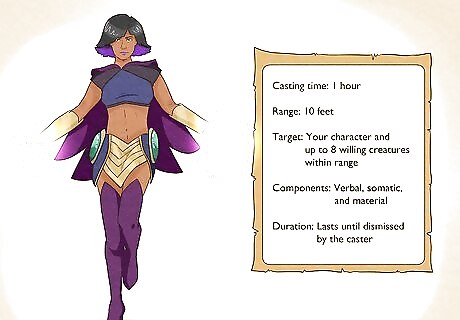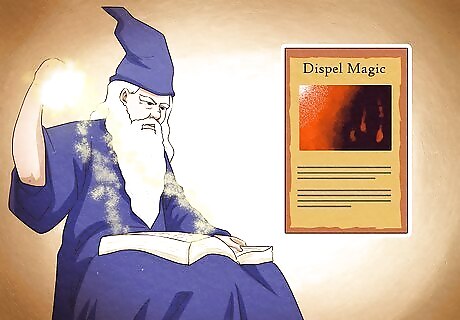
views
- Astral Projection is a 9th-level spell that lets your character project their form into the astral plane, complete with their normal stats and equipment.
- Use the Astral Projection spell to travel across the astral plane and even enter different worlds, as portals to virtually every world exist in the astral plane.
- Clerics, wizards, and warlocks are the 3 classes able to cast Astral Projection in 5e, though bards can also cast it by learning it with their Magical Secrets feat.
Astral Projection Spell Overview

Astral Projection is a 9th-level spell that allows access to the astral plane. In D&D 5e, there are many “planes” (or worlds) that player characters may be able to access over the course of the campaign. The astral plane is the plane of thought and psychic energy, a shapeless cloud surrounding all other planes. Most D&D campaigns take place on specific worlds like the Forgotten Realms or Eberron, but sometimes planar travel is allowed—and that’s where Astral Projection comes in. Casting time: 1 hour Range: 10 feet Target: Your character and up to 8 willing creatures within range Components: Verbal, somatic, and material Duration: Lasts until dismissed by the caster Fun fact: In D&D lore, the Astral Projection spell originated in the year -1791 DR at the hands of a Netherese arcanist, Valdick.
How does the Astral Projection spell work?

The spell creates an astral projection of your PC’s body on the astral plane. Their material form remains on the plane they left behind in a state of suspended animation, so it doesn’t need food or water. Their astral form has the same stats, appearance, and equipment that it normally does, with the exception of a thin, silvery cord extending from between their shoulder blades connecting them to their material body. As long as the silvery cord remains intact, your PC can find their way back to their original body and plane. If the cord is cut, their soul is separated from their body, killing them. Keep in mind that only an item or effect that specifically mentions cutting an astral projection cord is capable of doing so. Generally, those effects are up to the DM’s discretion, as D&D rules state that “very few” things can sever the cord. For example, a Githyanki’s silver sword or a Wish spell are both capable of doing so.

Your character’s astral form can traverse the astral plane freely. Once the spell is cast, your PC and any creatures they brought with them can both travel across the astral plane and use any portals they find. Because the astral plane surrounds all others, there are access points to nearly every plane throughout it—and, if you travel to a different plane, your PC’s physical body (along with any equipment) is transported there, allowing them to re-enter their body if they choose. Your PC’s astral form is separate from their body while the spell is active. Therefore, any damage their astral form takes doesn’t carry over to their physical body, even once the spell ends.

The Astral Projection spell ends when you use an action to dismiss it. Most spells in D&D 5e have a set duration, but Astral Projection’s duration is special. Most of the time, it ends when you take an action to drop the spell. However, there are other ways to end it as well—for example, a successful Dispel Magic spell can do the trick. Beyond that, if your PC (or any creature included in the spell) drops to 0 hit points, the spell ends for them. Hit points determine how much health your character has. When they lose all their hit points and drop to 0, they go unconscious. If your PC falls unconscious while Astral Projection is active, their astral form is pulled back to their body, and the spell ends, so long as their silver cord is intact. If you cast the spell and drop to 0 hit points, any creatures in the astral plane with you remain there and must find their way back to their own bodies, even if the spell ends. Usually, the easiest way for creatures to find their way back home is to drop to 0 hit points themselves, after which they’ll also be transported back to their bodies.

Material components are required for the spell. Some spells in D&D 5e require material components, which essentially means your PC will need to gather the necessary ingredients to cast the spell. Astral Projection requires 1 one jacinth (a type of gemstone) worth at least 1,000 gold pieces and 1 ornately carved bar of silver worth at least 100 gold pieces for each creature affected by the spell. All materials are consumed once the spell is cast. So, for example, if you wanted to cast Astral Projection on your PC and your 3 party members, you’d need 4 jacinth gemstones and 4 silver bars in total. Not every spell has such expensive requirements, but higher-level spells are more likely to come with them. As a level 9 spell, Astral Projection is one of the most powerful spells available!
How to Use Astral Projection in 5e

Explore the astral plane with the Astral Projection spell. The most basic reason to cast the Astral Projection spell is to visit the astral plane! It’s one of the few spells capable of taking the entire campaign to a different world, which is why it’s so powerful and high-level. If your character’s goal is to explore the astral plane, they might try to learn the Astral Projection spell in order to do so. For example, your PC might use the spell if they have enemies or allies among the githyanki, a race of people who live in the astral plane. Similarly, if your PC is an astral elf or has allies or enemies among the astral elves, they might use the spell to visit their home plane. Your PC might want to visit the Astral Sea, a perilous place with treasures from worlds across the D&D multiverse. The husks of dead gods often end up in the astral plane, though they still emit great power or energy. If your PC is searching for powerful components, they might travel to the astral plane to find what they need.

Use the Astral Projection spell to explore distant planes and worlds. Along with spells like Plane Shift and Gate, Astral Projection allows your PC to not only visit the astral plane but to go to virtually any world that exists within D&D lore (or beyond, if your DM wants to create their own world!) So, if your goal is to hop from one world to another, or your current quest involves traveling to a different plane, you might cast the Astral Projection spell to do so. For example, your PC might try to navigate the astral plane to move between material planes (which are basically the habitable worlds that most campaigns take place in). They might travel from Greyhawk to the Forgotten Realms, for example. Your PC might also travel from a material plane to a fantastical one, like Elysium, the Nine Hells, Arborea, Pandemonium, or Limbo. DM Tip: Astral Projection is a powerful spell that can expand the scope of your campaign at the drop of a hat, so be prepared if one of your players learns it! You might design a one-shot or quest that involves travel to a specific plane, for example.

Cast the Astral Projection spell outside of combat. Because it takes an hour to cast, Astral Projection isn’t the kind of spell that can be cast during combat. One round of combat is six seconds long, so any battle would be long over by the time you finished casting the spell. It’s not intended to be an easy form of teleportation or a quick escape for sticky situations; rather, cast it outside of combat if you actually need to reach the astral plane or a different world. If you want a “quick escape” spell to keep on hand when combat gets too rough, spells such as Teleport, Plane Shift, or even Gate are ideal—they take 1 action to cast, so they’re easier to pull off in the middle of a fight. Always check the casting time of a spell before learning it, just in case it takes longer to cast than you think it does. For example, Teleportation Circle (which is handy in that it allows you to teleport to a known circle) takes 1 minute to cast, which still isn’t ideal for combat.

Avoid the pitfalls of spells like Plane Shift and Gate with Astral Projection. Since Plane Shift (a level 8 spell) and Gate (a level 9 spell) both allow direct planar travel, you might wonder why Astral Projection is necessary at all. The biggest reason you might use Astral Projection over other spells while playing D&D is that the rulers of different realms (gods, demons, archfey, and so on) can block your entry if you use Plane Shift or Gate—but it’s much harder for them to stop you if you use Astral Projection. For example, the Gate spell’s description says, “Deities and other planar rulers can prevent portals created by this spell.” However, when you cast Astral Projection, your PC isn’t creating a portal; they’re simply gaining access to existing portals by entering the astral plane. Thus, if your PCs needed to sneak into a demon lord’s realm to take them down, for example, they might use the Astral Projection spell to enter the realm undetected.
Who can cast Astral Projection in 5e?

Clerics, wizards, and warlocks are capable of casting Astral Projection. All spells in D&D 5e belong to a specific class’s spell list, though many spells are available to multiple classes. If you want to cast the Astral Projection spell, play as a cleric (a divine spellcaster that serves the gods), a wizard (an arcane spellcaster who learns their craft through intense studies), or a warlock (an arcane spellcaster who gains spells by making a deal with a powerful entity). However, if you create a bard character, you might also be able to learn Astral Projection through your “Magical Secrets” feat. Bards get this feat 3 times as they level up and can learn 2 spells from outside their spell list each time.




















Comments
0 comment